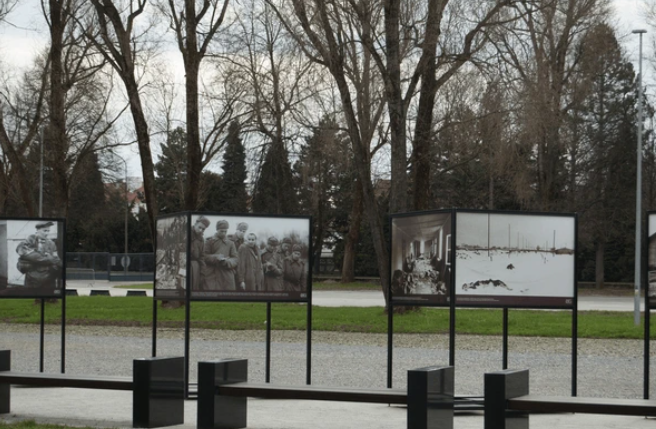Introduction: The Nine Years’ War and Its Impact on Europe
The Nine Years’ War (1688–1697), also known as the War of the Grand Alliance or the War of the League of Augsburg, was one of the most significant conflicts of the late 17th century. The war involved many of the great powers of Europe and was primarily a struggle between France, under the rule of King Louis XIV, and a coalition of European powers that sought to curb his territorial ambitions. The German territories, as part of the Holy Roman Empire, were deeply affected by the war, experiencing widespread devastation, economic hardship, and significant political change.
Read Also : Hitler’s Role in Shaping the Course of World War II: A Strategic Perspective (1939-1945)
The Causes of the Nine Years’ War: Ambition and Alliance
The origins of the Nine Years’ War can be traced back to the ambitious policies of Louis XIV, who sought to expand French influence across Europe, and the subsequent formation of the Grand Alliance, which aimed to counterbalance French power.
Louis XIV’s Ambitions: Expanding French Influence
Louis XIV, known as the Sun King, had grand ambitions to expand French territories and assert his dominance in Europe. His aggressive foreign policies, particularly his efforts to extend French control into the Rhineland, alarmed the other European powers. The Rhineland, a region along the western borders of the Holy Roman Empire, was of great strategic importance due to its economic resources and its position as a buffer zone. Louis XIV’s desire to control this region was a key factor in his expansionist policies.
Before the Nine Years’ War, Louis XIV had already engaged in several conflicts that demonstrated his expansionist goals, such as the War of the Reunions (1683–1684), where he successfully annexed several territories in the Rhineland. These earlier successes emboldened him to push further, leading to increased tensions with neighboring states. The combination of territorial ambitions and previous military successes set the stage for a broader conflict that would involve much of Europe.
In addition to territorial ambitions, Louis XIV’s support for the claims of his sister-in-law to the Palatinate, a major German territory, added a dynastic element to the territorial disputes. This claim was seen as a direct challenge to the sovereignty of the Holy Roman Empire, exacerbating tensions within the region. The combination of territorial expansion and dynastic claims created a volatile situation that would eventually explode into the Nine Years’ War.
The Formation of the Grand Alliance: A Unified Response
In response to Louis XIV’s aggressive expansionism, a coalition of European powers formed the Grand Alliance, aiming to curb French influence and maintain the balance of power in Europe. The Holy Roman Emperor Leopold I, King William III of England, and the Dutch Republic were key members of this alliance. The Grand Alliance sought to defend the sovereignty of the Holy Roman Empire and prevent the further expansion of French power into German territories.
The formation of the Grand Alliance was a significant development in European politics, as it represented a concerted effort by multiple states to resist the hegemony of France. The alliance was not only a military coalition but also a diplomatic effort to isolate France and limit its influence in European affairs. The combined military and economic resources of the alliance members made it a formidable opponent for Louis XIV, setting the stage for a prolonged and costly conflict.
The war that ensued was marked by a series of military campaigns across Europe, with the German territories becoming one of the principal battlegrounds. The involvement of the Holy Roman Empire in the Grand Alliance was crucial, as it provided the coalition with a strong base of operations in central Europe. The alliance’s ability to coordinate its military efforts across multiple fronts was a key factor in its eventual success in curbing French expansion.
Dynastic Disputes and Regional Tensions
The Nine Years’ War was also fueled by a complex web of dynastic disputes and regional tensions that exacerbated the conflict. Louis XIV’s claims to the Palatinate, for example, were rooted in family ties but were also a pretext for expanding French influence in the region. These disputes created a sense of insecurity among the German states, which feared the loss of their autonomy to French aggression.
The tension between Protestant and Catholic states within the Holy Roman Empire also played a role in the conflict. While the primary cause of the war was territorial and political, religious differences added another layer of complexity to the alliances and enmities that developed during the war. The fear of religious persecution and the desire to protect religious freedoms motivated many of the German states to join the Grand Alliance and resist French domination.
The involvement of various regional powers in the conflict further complicated the situation. Smaller states within the Holy Roman Empire, as well as neighboring countries like Spain and Sweden, had their own interests and grievances that influenced their participation in the war. These regional tensions and disputes contributed to the protracted nature of the conflict and made it difficult to achieve a lasting peace.
Economic Motivations Behind the Conflict
The war was not only about territorial control but also had significant economic motivations. Control over the Rhineland meant control over key trade routes and resources, which were essential for the economic strength of the involved powers. The French crown sought to secure these economic advantages to fuel its military ambitions and strengthen its economy, particularly in the face of mounting costs from previous wars.
The economic dimension of the conflict was particularly important for the German territories, which were heavily dependent on trade and agriculture. The disruption of trade routes and the destruction of farmland had a devastating impact on the local economy, leading to widespread hardship and suffering. The economic motivations behind the war also influenced the strategies and decisions of the involved powers, as they sought to maximize their gains while minimizing their losses.
The economic impact of the war was not limited to the immediate participants. The broader European economy was affected by the disruption of trade and the diversion of resources to the war effort. The costs of the conflict were felt across the continent, leading to inflation, shortages, and social unrest in many countries. The economic consequences of the war would linger for years, shaping the future development of the affected regions.
The Role of Diplomacy and Failed Negotiations
Diplomacy played a crucial role in the events leading up to the Nine Years’ War. Despite numerous attempts to negotiate a peaceful resolution to the tensions between France and the other European powers, these efforts ultimately failed. The collapse of diplomatic talks underscored the deep mistrust and competing interests that characterized the relationships between the major European powers at the time.
The inability to reach a diplomatic solution meant that war became increasingly inevitable. The breakdown in negotiations highlighted the limitations of the diplomatic channels available at the time and the willingness of the parties involved to resort to military conflict to achieve their objectives. The failure of diplomacy also had long-term consequences for European politics, as it contributed to the development of more formalized alliances and treaties in the years that followed.
The war itself saw several attempts at negotiation, particularly during periods of stalemate or exhaustion. However, these efforts were often undermined by the intransigence of the involved parties and the complexity of the issues at stake. The eventual resolution of the conflict through the Treaty of Ryswick was a testament to the difficulty of achieving a lasting peace in a context of deep-seated animosities and competing ambitions.
The War in the German Territories: Devastation and Destruction
The German territories, particularly those along the Rhine, bore the brunt of much of the fighting during the Nine Years’ War. The conflict brought widespread destruction, economic hardship, and social upheaval to the region.
The Rhineland Campaigns: A Battleground for Europe
The Rhineland became one of the primary theaters of the Nine Years’ War. The region was home to several key fortresses and cities, including Mainz, Bonn, and Heidelberg, which were heavily contested by both French and allied forces. The French strategy in the Rhineland involved a series of aggressive offensives aimed at securing key positions and disrupting the operations of the Grand Alliance.
Louis XIV’s forces launched numerous attacks on German cities and fortresses, often employing scorched earth tactics to devastate the countryside. The French destruction of the Palatinate in 1689, known as the “Devastation of the Palatinate,” was particularly notorious for its brutality, leaving behind a trail of ruined towns and displaced civilians. The destruction of these key fortresses not only had immediate military implications but also long-term effects on the region’s stability and prosperity.
The Rhineland campaigns were characterized by a high level of violence and destruction, with both sides engaging in practices that targeted civilian populations and infrastructure. The region’s strategic importance made it a focal point of the conflict, leading to repeated cycles of occupation, liberation, and devastation. The impact of these campaigns was felt not only by the combatants but also by the local populations, who suffered the consequences of a war fought in their midst.
The Economic and Social Impact: Hardship and Displacement
The war had a devastating impact on the economy and society of the German territories. The constant military campaigns, combined with scorched earth tactics, led to widespread destruction of farmland, infrastructure, and homes. Many regions experienced severe food shortages, famine, and outbreaks of disease, exacerbating the suffering of the civilian population.
The social impact was equally severe, with thousands of people forced to flee their homes to escape the fighting. The displacement of populations led to overcrowding in safer regions, further straining resources and social stability. The rebuilding process after the war was slow and difficult, with many communities struggling to recover from the losses they had sustained.
The economic impact of the war was felt for years after the conflict ended. The destruction of crops and livestock led to a decline in agricultural production, which in turn caused food prices to rise and contributed to economic hardship. The disruption of trade routes and the loss of access to key markets further compounded the economic challenges faced by the German territories. The long-term consequences of the war included a weakening of the local economies and a decline in the overall standard of living for many inhabitants.
The Strategic Importance of Key German Cities
Several German cities played a crucial role in the Nine Years’ War, both as strategic military targets and as symbols of resistance against French aggression. Cities like Cologne, Mainz, and Heidelberg were repeatedly contested throughout the war, with their fortifications and defensive positions making them key points of focus for both the French and the Grand Alliance.
These cities were not only important for their military value but also for their economic and political significance within the Holy Roman Empire. The loss or defense of these cities had far-reaching consequences for the broader conflict and the stability of the German territories. The repeated battles for control of these cities also took a heavy toll on their populations, leading to widespread destruction and loss of life.
The strategic importance of these cities meant that they were often the sites of protracted sieges and brutal urban warfare. The impact of the conflict on these cities was devastating, with many of them suffering significant damage to their infrastructure and economy. The rebuilding process after the war was slow and costly, with some cities never fully recovering from the devastation they had endured.
The Role of Local German Nobility
The local nobility in the German territories played a significant role in the Nine Years’ War, both as military leaders and as political actors. Many German princes and dukes aligned themselves with the Grand Alliance, contributing troops and resources to the war effort in defense of their lands and sovereignty.
However, the war also revealed the fractured nature of the Holy Roman Empire, with some nobles seeking to protect their own interests rather than contribute to a unified imperial defense. This lack of cohesion within the empire made it more difficult to effectively resist French advances and contributed to the widespread devastation of the German territories.
The involvement of the local nobility also had long-term political implications for the Holy Roman Empire. The war exposed the limitations of the emperor’s authority and highlighted the need for greater unity and coordination among the German states. In the aftermath of the conflict, there were calls for reform and centralization within the empire, though these efforts would face significant resistance from the various regional powers.
The Long-term Consequences for the German Territories
The Nine Years’ War had lasting consequences for the German territories, shaping the political and economic landscape of the region for years to come. The destruction wrought by the war, coupled with the economic hardship it caused, left many areas struggling to recover well into the 18th century.
The war also led to significant political changes within the Holy Roman Empire, with some territories gaining greater autonomy while others saw their influence diminished. The rise of Prussia as a major power within the empire was one of the most significant outcomes of the conflict, setting the stage for future shifts in the balance of power within the German territories.
The long-term consequences of the war included a weakening of the Holy Roman Empire as a political entity and the emergence of more powerful regional states. The economic and social impact of the conflict also contributed to a sense of disillusionment and unrest within the German territories, which would have far-reaching implications for the future of the region. The legacy of the Nine Years’ War was a complex and multifaceted one, with its effects felt long after the conflict had ended.
The Treaty of Ryswick: An Uneasy Peace
The Nine Years’ War came to an end with the signing of the Treaty of Ryswick in September 1697. The treaty brought an uneasy peace to Europe, but its terms reflected the complex and unresolved nature of the conflict.
The Terms of the Treaty: A Return to the Status Quo
The Treaty of Ryswick largely restored the territorial boundaries that had existed before the war, with France agreeing to return most of the territories it had occupied during the conflict. The Rhineland, including the Palatinate, was returned to the Holy Roman Empire, and the French fortifications in the region were dismantled.
However, the treaty did not resolve the underlying tensions that had led to the war. While the Grand Alliance had succeeded in curbing French expansion, the balance of power in Europe remained precarious. The treaty was seen as a temporary solution rather than a lasting settlement, and many of the issues that had driven the conflict would resurface in the years to come.
For the German territories, the Treaty of Ryswick provided a measure of relief, but the scars of the war were slow to heal. The economic and social damage inflicted by the conflict would take years, if not decades, to fully repair. The treaty also left unresolved questions about the future of the Holy Roman Empire and the balance of power within the German territories.
The Political Implications of the Treaty
The Treaty of Ryswick had significant political implications for the European powers involved, particularly for the German territories. The treaty reinforced the status quo, but it also highlighted the limitations of the Holy Roman Empire’s political structure. The fragmented nature of the empire made it difficult to present a unified front during the war, and this weakness was exposed in the peace negotiations.
The treaty also had implications for the broader European balance of power. While the Grand Alliance succeeded in curbing French expansion, the underlying tensions between the major powers remained unresolved. The treaty was a temporary solution that postponed, rather than resolved, the conflicts that would eventually lead to the War of the Spanish Succession just a few years later.
The German territories, in particular, were left in a vulnerable position. The devastation of the war, coupled with the lack of a clear resolution to the underlying issues, left the region weakened and divided. The long-term consequences of the treaty included a shift in the balance of power within the Holy Roman Empire, with some states gaining greater autonomy while others saw their influence diminish.
The Economic Consequences of the Treaty
The economic consequences of the Treaty of Ryswick were felt across Europe, but they were particularly severe in the German territories. The war had devastated the region’s economy, and the treaty did little to address the underlying economic issues. The disruption of trade routes, the destruction of infrastructure, and the loss of agricultural production had long-term effects on the region’s economic stability.
The rebuilding process after the war was slow and costly, with many regions struggling to recover. The economic hardship faced by the German territories contributed to social unrest and political instability in the years following the treaty. The lack of economic recovery also made the region more vulnerable to future conflicts, as the weakened economy made it difficult to fund military defenses and maintain political stability.
The economic impact of the treaty also extended beyond the immediate aftermath of the war. The long-term consequences included a decline in the overall standard of living for many inhabitants of the German territories, as well as a shift in the economic balance of power within the Holy Roman Empire. The economic challenges faced by the region would continue to shape its development for years to come.
The Social Impact of the Treaty
The social impact of the Treaty of Ryswick was also significant, particularly in the German territories. The war had caused widespread displacement and suffering, and the treaty did little to address the needs of the affected populations. The slow process of rebuilding and recovery left many communities struggling to cope with the long-term effects of the conflict.
The displacement of populations during the war had led to overcrowding in safer regions, further straining resources and social stability. The social fabric of many communities was severely disrupted, with the war leaving behind a legacy of poverty, trauma, and instability. The treaty’s failure to address these social issues meant that the long-term consequences of the war would continue to be felt for years to come.
The social impact of the treaty also had political implications, as the social unrest and economic hardship contributed to a sense of disillusionment and discontent within the German territories. The failure to address the underlying social issues left the region vulnerable to future conflicts and political instability.
The Legacy of the Treaty and the War
The legacy of the Treaty of Ryswick and the Nine Years’ War was a complex one, with far-reaching consequences for Europe and the German territories in particular. The treaty brought an end to the immediate conflict, but it did not resolve the underlying issues that had led to the war. The unresolved tensions between the major European powers, coupled with the devastation and hardship caused by the war, set the stage for future conflicts.
The war and the treaty also had significant long-term effects on the political and economic landscape of the German territories. The war exposed the weaknesses of the Holy Roman Empire and led to a shift in the balance of power within the region. The economic and social consequences of the conflict left the region weakened and divided, contributing to a sense of disillusionment and unrest that would have far-reaching implications for the future of the region.
The legacy of the Treaty of Ryswick and the Nine Years’ War is a reminder of the complex and multifaceted nature of conflict and diplomacy. The war and its aftermath had profound effects on the political, economic, and social landscape of Europe, shaping the course of European history for years to come.
Conclusion: The Lasting Impact of the Nine Years’ War on the German Territories
The Nine Years’ War was a devastating conflict that had a profound impact on the German territories within the Holy Roman Empire. The war brought widespread destruction, economic hardship, and social upheaval to the region, leaving a lasting legacy that would shape the future of the region for years to come. The Treaty of Ryswick brought an end to the immediate conflict, but it did not resolve the underlying issues that had led to the war, leaving the region vulnerable to future conflicts.
The long-term consequences of the war included a shift in the balance of power within the Holy Roman Empire, with some territories gaining greater autonomy while others saw their influence diminished. The economic and social impact of the conflict also contributed to a sense of disillusionment and unrest within the German territories, which would have far-reaching implications for the future of the region. The legacy of the Nine Years’ War is a reminder of the complex and multifaceted nature of conflict and diplomacy, and the long-term impact of war on the political, economic, and social landscape of a region.
FAQ About the Nine Years’ War and the German Territories
What was the Nine Years’ War?
The Nine Years’ War (1688–1697) was a major conflict in Europe involving France and a coalition of European powers, including the Holy Roman Empire, England, and the Dutch Republic. The war was primarily a struggle to curb the expansionist ambitions of King Louis XIV of France.
How did the Nine Years’ War affect the German territories?
The war had a devastating impact on the German territories, particularly those along the Rhine. The conflict brought widespread destruction, economic hardship, and social upheaval to the region, with long-term consequences for the political, economic, and social landscape of the region.
What was the Treaty of Ryswick?
The Treaty of Ryswick, signed in 1697, brought an end to the Nine Years’ War. The treaty largely restored the territorial boundaries that had existed before the war and brought a temporary peace to Europe, though it did not resolve the underlying tensions that had led to the conflict.
What were the long-term consequences of the Nine Years’ War?
The long-term consequences of the war included a shift in the balance of power within the Holy Roman Empire, with some territories gaining greater autonomy while others saw their influence diminished. The war also had a significant economic and social impact, leaving the region weakened and divided.
How did the Nine Years’ War shape the future of Europe?
The Nine Years’ War had a profound impact on the political, economic, and social landscape of Europe, setting the stage for future conflicts and shaping the course of European history. The unresolved tensions and underlying issues that led to the war would resurface in future conflicts, including the War of the Spanish Succession.







2 comments